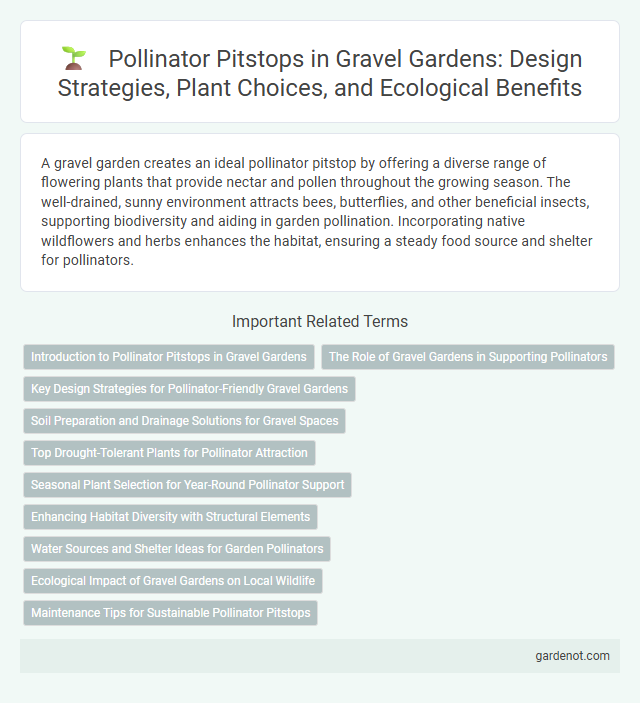A gravel garden creates an ideal pollinator pitstop by offering a diverse range of flowering plants that provide nectar and pollen throughout the growing season. The well-drained, sunny environment attracts bees, butterflies, and other beneficial insects, supporting biodiversity and aiding in garden pollination. Incorporating native wildflowers and herbs enhances the habitat, ensuring a steady food source and shelter for pollinators.
Introduction to Pollinator Pitstops in Gravel Gardens
Pollinator Pitstops in gravel gardens create vital habitats by incorporating native flowering plants that attract bees, butterflies, and other beneficial insects. These mini ecosystems support biodiversity and enhance pollination, contributing to healthy garden productivity. Incorporating diverse, nectar-rich species optimizes habitat value and ensures continuous blooms throughout the growing season.
The Role of Gravel Gardens in Supporting Pollinators
Gravel gardens create an essential habitat by providing well-drained, nutrient-poor soils favored by many native pollinator species such as solitary bees and butterflies. These gardens offer abundant early nectar and pollen sources, critical for the survival and reproduction of pollinators throughout changing seasons. Integrating gravel garden designs into urban and rural landscapes supports biodiversity by enhancing pollinator diversity and resilience against habitat loss.
Key Design Strategies for Pollinator-Friendly Gravel Gardens
In designing a pollinator-friendly gravel garden, integrating diverse native flowering plants throughout the gravel provides essential nectar sources and habitat. Structuring varied plant heights and bloom times maximizes year-round food availability for bees, butterflies, and other pollinators. Incorporating shallow water features and avoiding chemical pesticides further supports a thriving pollinator ecosystem within the gravel garden environment.
Soil Preparation and Drainage Solutions for Gravel Spaces
Soil preparation for pollinator pitstops in gravel gardens involves loosening compacted soil and incorporating organic matter to enhance nutrient content and moisture retention. Effective drainage solutions include creating sloped surfaces or installing permeable layers beneath the gravel to prevent waterlogging and ensure healthy root growth for native flowering plants. Proper management of soil texture and drainage directly supports pollinator habitat by promoting robust plant establishment and continuous floral resources.
Top Drought-Tolerant Plants for Pollinator Attraction
Top drought-tolerant plants for pollinator attraction in gravel gardens include Echinacea purpurea, lavender (Lavandula angustifolia), and Sedum spectabile. These species thrive in well-drained, low-moisture environments while providing essential nectar and pollen for bees, butterflies, and other pollinators. Incorporating these resilient plants enhances biodiversity and supports pollinator health during dry conditions.
Seasonal Plant Selection for Year-Round Pollinator Support
Seasonal plant selection in a gravel garden ensures continuous nectar and pollen sources for pollinators throughout the year, supporting species such as bees, butterflies, and hoverflies. Incorporating early bloomers like crocus and hellebore, mid-season flowers such as echinacea and lavender, and late bloomers like asters and sedum creates a diverse habitat that attracts and sustains pollinating insects. This strategic planting enhances biodiversity while maintaining low water use and soil stability in gravel gardens.
Enhancing Habitat Diversity with Structural Elements
Pollinator pitstops in gravel gardens enhance habitat diversity by incorporating varied structural elements such as nesting blocks, bare soil patches, and native plant clusters. These features provide essential resources for bees, butterflies, and other pollinators, promoting foraging and breeding opportunities within the ecosystem. Integrating diverse textures and microhabitats increases resilience and supports a wide range of pollinator species year-round.
Water Sources and Shelter Ideas for Garden Pollinators
Water sources such as shallow birdbaths, mud puddles, and small drip bowls provide essential hydration for garden pollinators like bees and butterflies. Incorporating shelter ideas like hollow stems, bee hotels, and dense ground cover offers safe nesting and resting spots. These elements create a thriving environment for pollinators, enhancing biodiversity in gravel garden ecosystems.
Ecological Impact of Gravel Gardens on Local Wildlife
Gravel gardens create a vital pollinator pitstop by providing diverse nectar sources and nesting habitats that support bees, butterflies, and other beneficial insects. The porous soil and plant diversity enhance local biodiversity, improving ecosystem resilience and promoting sustainable wildlife populations. Integrating native flowering plants within gravel gardens fosters ecological balance by attracting a wide range of pollinators essential for local plant reproduction.
Maintenance Tips for Sustainable Pollinator Pitstops
Regularly removing invasive weeds and deadheading spent flowers in gravel gardens enhances the health and attractiveness of pollinator pitstops. Monitoring soil moisture and ensuring proper drainage prevent root rot and support diverse pollinator species. Incorporating native flowering plants and avoiding pesticides fosters a sustainable habitat for bees, butterflies, and other beneficial insects.
Pollinator pitstop Infographic

 gardenot.com
gardenot.com